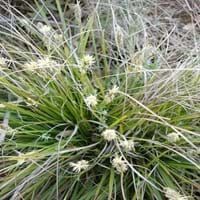Life Span
Annual and Perennial
Perennial
Type
Tender Perennial
Sedge or Rush
Origin
South Africa
Japan
Types
Osteospermum acanthospermum, Osteospermum amplectens, Osteospermum burttianum
Narrow sedge
Number of Varieties
Not Available
Habitat
Coastal Regions, Sandy areas, Terrestrial
Boggy areas, ditches, marshes, riparian zones, stream banks, Tropical regions, Wet forest
USDA Hardiness Zone
10-11
6-9
AHS Heat Zone
Not Available
9-6
Sunset Zone
8, 9, 12, 13, 14, 15, 16, 17, 18, 19, 20, 21, 22, 23, 24
3a, 3b, 4, 5, 6, 7, 8, 9, 14, 15, 16, 17, 18, 19, 20, 21, 22, 23, 24
Habit
Clump-Forming
Arching/Fountain-shaped
Flower Color
White, Purple, Blue Violet
Brown
Flower Color Modifier
Bicolor
Bicolor
Fruit Color
Not Available
Not Available
Leaf Color in Spring
Green
Dark Green, Light Yellow
Leaf Color in Summer
Green
Dark Green, Light Yellow
Leaf Color in Fall
Green, Blue Green
Dark Green, Light Yellow
Leaf Color in Winter
Light Green
Dark Green, Light Yellow
Leaf Shape
Irregular
Long Linear
Plant Season
Spring, Summer, Fall
Spring, Summer, Fall, Winter
Sunlight
Full Sun, Partial Sun
Partial Sun, Partial shade
Type of Soil
Loam
Clay, Loam, Sand
The pH of Soil
Neutral
Acidic, Neutral, Alkaline
Soil Drainage
Well drained
Well drained
Bloom Time
Late Spring, Early Summer, Summer, Late Summer, Early Fall, Fall
Spring
Tolerances
Drought
Drought, Heat Tolerance
Where to Plant?
Container
Container, Ground, Pot
How to Plant?
Seedlings, Stem Cutting
Seedlings
Plant Maintenance
Medium
Low
Watering Requirements
Do Not over Water, Keep ground moist
Average Water Needs, Do Not over Water, Never Over-water, Prefer drip-irrigation instead of Over-head watering, Requires regular watering
In Summer
Lots of watering
Ample Water
In Spring
Moderate
Ample Water
In Winter
Average Water
Average Water
Soil pH
Neutral
Acidic, Neutral, Alkaline
Soil Type
Loam
Clay, Loam, Sand
Soil Drainage Capacity
Well drained
Well drained
Sun Exposure
Full Sun, Partial Sun
Partial Sun, Partial shade
Pruning
Remove damaged leaves, Remove dead branches, Remove dead leaves
Remove damaged leaves, Remove dead leaves
Fertilizers
All-Purpose Liquid Fertilizer
organic fertlizers, very little fertilizers at a time, Water soluble fertilizers
Pests and Diseases
Red blotch
Aphids, Mealybugs, Red blotch, Scale, Slugs
Plant Tolerance
Drought
Dry Conditions, Heat Tolerance
Flowers
Showy
Insignificant
Flower Petal Number
Single
Single
Foliage Texture
Medium
Fine
Foliage Sheen
Not Available
Glossy
Attracts
Bees, Birds, Butterflies
Insects, Mealybugs
Allergy
Not Available
Asthma
Aesthetic Uses
Beautification, Showy Purposes
Beautification, Borders, Cottage Garden, Landscape Designing, Showy Purposes
Beauty Benefits
Not Available
No Beauty Benefits
Environmental Uses
Air purification
Air purification, Food for insects, Shelter for wildlife, Versatility, Wildlife
Medicinal Uses
Not Applicable
Diuretic
Part of Plant Used
Flowers
Leaves
Other Uses
Used as Ornamental plant
Decoration Purposes, Showy Purposes, Used as Ornamental plant
Used As Indoor Plant
No
Yes
Used As Outdoor Plant
Yes
Yes
Garden Design
Bedding Plant, Container, Cutflower, Foundation, Groundcover, Hanging Basket, Mixed Border, Rock Garden / Wall
Container, Edging, Foundation, Groundcover, Mixed Border
Botanical Name
OSTEOSPERMUM fruticosum
CAREX oshimensis 'Supergold'
Common Name
Shrubby Daisybush, Trailing African Daisy
Sedge
In Hindi
Blue Eyed Daisy Plant
evergold Sedge
In German
Blue Eyed Daisy Pflanze
Evergold Segge
In French
Blue Eyed Daisy Plante
Evergold carex
In Spanish
Planta observada azul de la margarita
Evergold juncia
In Greek
Μπλε Eyed Daisy Φυτών
evergold σπαθόχορτο
In Portuguese
Planta da margarida de olhos azuis
Evergold Sedge
In Polish
Blue Eyed Daisy roślin
Evergold turzyca
In Latin
Daisy Blue Eyed Planta
evergold Sedge
Phylum
Magnoliophyta
Tracheophyta
Class
Magnoliopsida
Liliopsida
Family
Asteraceae
Cyperaceae
Clade
Angiosperms, Asterids, Eudicots
Angiosperms, Commelinids, Monocots
Tribe
Calenduleae
Cariceae
Subfamily
Asteroideae
Cyperoideae
Season and Care of Blue Eyed Daisy Plant and Evergold Sedge
Season and care of Blue Eyed Daisy Plant and Evergold Sedge is important to know. While considering everything about Blue Eyed Daisy Plant and Evergold Sedge Care, growing season is an essential factor. Blue Eyed Daisy Plant season is Spring, Summer and Fall and Evergold Sedge season is Spring, Summer and Fall. The type of soil for Blue Eyed Daisy Plant is Loam and for Evergold Sedge is Clay, Loam, Sand while the PH of soil for Blue Eyed Daisy Plant is Neutral and for Evergold Sedge is Acidic, Neutral, Alkaline.
Blue Eyed Daisy Plant and Evergold Sedge Physical Information
Blue Eyed Daisy Plant and Evergold Sedge physical information is very important for comparison. Blue Eyed Daisy Plant height is 36.00 cm and width 51.00 cm whereas Evergold Sedge height is 25.40 cm and width 30.50 cm. The color specification of Blue Eyed Daisy Plant and Evergold Sedge are as follows:
Blue Eyed Daisy Plant flower color: White, Purple and Blue Violet
Blue Eyed Daisy Plant leaf color: Green
Evergold Sedge flower color: Brown
- Evergold Sedge leaf color: Dark Green and Light Yellow
Care of Blue Eyed Daisy Plant and Evergold Sedge
Care of Blue Eyed Daisy Plant and Evergold Sedge include pruning, fertilizers, watering etc. Blue Eyed Daisy Plant pruning is done Remove damaged leaves, Remove dead branches and Remove dead leaves and Evergold Sedge pruning is done Remove damaged leaves and Remove dead leaves. In summer Blue Eyed Daisy Plant needs Lots of watering and in winter, it needs Average Water. Whereas, in summer Evergold Sedge needs Ample Water and in winter, it needs Average Water.





